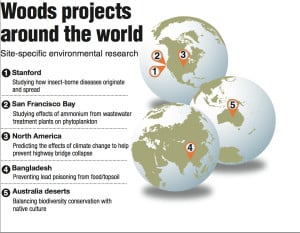
The Stanford Woods Institute for the Environment has announced its latest crop of Environmental Venture Projects (EVP), each of which will receive funding over the next two years to tackle significant environmental issues worldwide.
The grants for the seven projects total nearly $1.25 million. The selection process aimed to identify interdisciplinary research—with faculty members coming from fields as diverse as anthropology and physics—that sought practical solutions to global problems.
“It’s a really interesting funding mechanism,” said Michael Hsieh ‘93, assistant professor of urology and grant recipient. “They specifically want interdisciplinary efforts, so, for example, at least one investigator on every EVP project needs to be outside of the Woods Institute.”
This year’s projects span five continents, from one endeavor that aims to understand the effects of ammonium on marine life in the nearby San Francisco Bay Delta, to another that hopes to alleviate lead contamination in food and topsoil in rural Bangladesh. The new grant recipients join 49 other Woods Institute funded research teams working in 24 countries around the world.
The newly funded projects also cover a wide variety of disciplines, with several departments being represented for the first time.
Formed in 2004 to provide sustainable sources of food, water and other vital needs to communities around the world, the Woods Institute for the Environment has continually devoted itself to interdisciplinary work, with involvement from faculty from all seven of Stanford’s schools.
Past EVPs have led to successful advancement in a variety of fields, from new wastewater treatment technology to biodegradable building materials to endangered species protection in California.
Recipients of the project funds passed a rigorous two-tiered application process. In early January, applicants presented a letter of intent. From this pool, teams that the selection committee deemed competitive were asked to submit a full proposal in early April.
The selection process prioritized projects that are “high-risk” and “transformative,” with a focus on practical solutions to significant problems. Teams were also required to represent new collaborations between faculties who have not worked together in the past, with preference given to teams who have not worked with the Woods Institute before.
In addition to the project in the San Francisco Bay Delta, North American-based projects include a new, more efficient way of conducting marine life censuses using environmental DNA, tissue and waste cells found in water samples; and a project to predict the effects of climate change on infrastructure to prevent highway bridge failure.
Other grant recipients include a project to balance cultural sustainability and environmental conservation in the deserts of Australia; a study on insect-parasite interactions that aims to help predict global outbreaks of insect-borne diseases; and an effort to control schistosomiasis, a parasitic infection spread by freshwater snails in Africa, Asia and South America, by introducing river prawns, a natural predator.
Hsieh, the principal investigator on the schistosomiasis project, explained that Woods Institute funding can be the key for expanding projects to produce the desired results.
“Initial results were very promising, but we want to expand out into additional sites, and do more intensive, theoretical modeling as to what parameters are important for prawn predation of snails, and its effects on rates of human infection,” Hsieh said. “So that’s our hope in terms of what EVP funding will allow us to do.”
Woods Institute Senior Fellow and Associate Professor of Anthropology Jamie Jones lauded this year’s grant recipients alongside their competitors in a Woods Institute report.
“The proposals submitted to this year’s EVP competition were amazingly broad and represent the most exciting qualities of research at Stanford,” Jones said. “They were intellectually rigorous, leading-edge, interdisciplinary and solutions-oriented. It was no minor challenge picking the top proposals from this field.”
Contact Sabelle Smythe at issmythe ‘at’ stanford.edu.